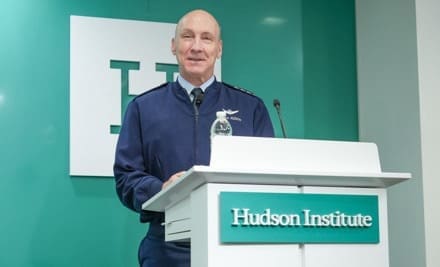
WASHINGTON (AFNS) —
Air Force Chief of Staff Gen. David Allvin said the Air Force must continue evolving into a highly integrated and lethal “one Air Force” if it is to successfully compete, deter, and win in today’s strategic environment.
Allvin’s assessment came during remarks on Aug. 16 at the Hudson Institute, a Washington, D.C.-based think tank, that offered additional detail on the service’s efforts to reoptimize itself to meet a new era of Great Power Competition head-on.
“As long as I am in this seat, I’m looking to evolve our Air Force,” said Allvin. “I’m very pleased with the progress thus far.”
To do this, he stated the force must emphasize mission over function to become one Air Force. He highlighted the importance of prioritizing mission effectiveness rather than functional competence as a foundation for the Air Force to develop new capabilities, rapidly project power, and execute missions effectively and efficiently.
“One Air Force [means bringing the force] back together and integrating to meet the threat and the environment,” said Allvin. “We need one Air Force that’s one fighting force with one force design.”
During his remarks, Allvin discussed how the Air Force must deliver combat-effective, agile, and adaptive airpower at scale, especially as it relates to the growing challenge in the Pacific posed by China.
“We have to make sure we have the Air Force we need so if competition turns to potential conflict, we can either deter that conflict or decisively win it if called upon,” said Allvin.
The ideas and priorities Allvin emphasized are part of an ambitious retooling of the Department of the Air Force unveiled in February dubbed “Reoptimizing for Great Power Competition.” That effort is designed as a forceful mechanism to move the Air Force from being primarily focused – and configured – to fighting the Global War on Terror to a much different force ready to confront a well-equipped and capable adversary, such as China.
“If we don’t do it now, we’re going to pay for it later,” Allvin explained while addressing the need to adapt. “Whatever we do or don’t do today will impact how well the future fight goes … The environment is here – we have to adapt to it.”
Allvin stressed repeatedly in his opening remarks at Hudson and later during a Q&A session that the Air Force cannot be a “diffuse” service. The Total Force, he said, must be forged into an aligned and unified one in which Airmen are mission-ready and wings deploy as units of action in a way that is seamless and dominant.
Allvin added how, over time, the Air Force has become fragmented as it adapted to previous security environments.
“Since the last time we were in Great Power Competition, our Air Force has become more diffused, and maybe more stovepipes have been created, and we really haven’t realigned ourselves because we haven’t had a sort of existential threat against which we should align ourselves,” said Allvin.
Allvin highlighted the Air Force remains the best and most capable in the world but stressed that status is not guaranteed in the future; the decisions the service makes now carry greater weight for future outcomes.
In total, the service’s reoptimization effort marks the largest retooling of the Air Force in over a generation. In response to a question about how the service is coping with putting in place such substantial change, Allvin offered encouragement.
“I’m a bit surprised at how fast we’re going,” he said, noting that the assessment measures only the first six months of a much longer journey. At the same time, he said the success to date is rooted in the way “our Airmen get it,” meaning that they understand “the why” and the urgency surrounding reoptimization.
By TSgt Nick Z. Erwin, Secretary of the Air Force Public Affairs

